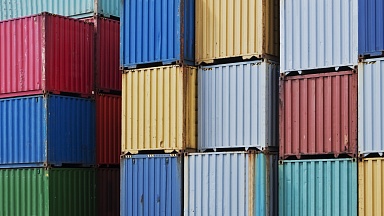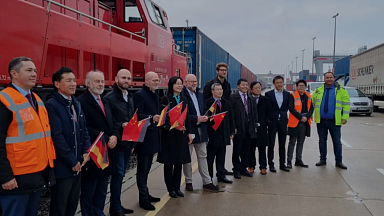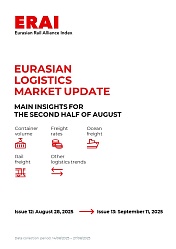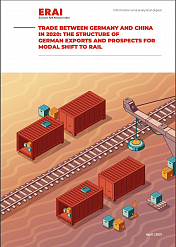1. What is your assessment of the prevailing sentiment on Russia’s container market?
One of the Price Benchmark Centre’s (PBC) latest reports on the Russian container market is titled «September of Unmet Expectations,» which reflects the fact that the low season in container shipping has ended, but the usual for the early autumn surge in cargo flow from China to Russia failed to materialised. Carriers look forward to seeing the market revive and started gradually raising rates on certain sea and rail services in August-September. However, a portion of ongoing tariff increases is artificial (due to reduced carrying capacity), while cargo flows are recovering at a low pace. Nevertheless, there are drivers that will send market and freight rates higher. They include the approaching high New Year season, an increase in traffic due to deferred demand for consumer good shipments in the wake of the Bank of Russia easing its monetary policy, and possible geopolitical flare-ups or even infrastructure challenges that often constrain rail container transport.
The container market players continue to develop the logistics infrastructure and see both the necessity and the demand for opening new routes and services, particularly with destinations in Africa and Latin America. At the same time, the market participants are hoping for a quick recovery in import volumes from China, although I would be cautious with such forecasts. In any case, the PBC continues to regularly track rail and sea container shipment rates, container allocation, and leasing of fitting platforms and containerships, in other words, indicators that make it possible to come up with up-to-the-minute assessments of the state of the transport and logistics market, as well as that of the Russian economy and foreign trade more generally, and that also serve as leading indicators for conducting stress tests and analysis.
2. What trends did you spot on the Russian container market this year? How and why are rail container transport rates changing?
We have been living amid a controlled slowdown of the Russian economy for almost all of this year, and transport market participants and other economic agents can sense its effects. The container market has cooled off as well, and as of the end of 2025, for the first time in the past 10 years, the Russian Railways’ container shipments will see a drop year-on-year. The PBC is primarily focusing on the import volume drop: the household consumer demand is low, warehouses remain overstocked, and importers are not motivated to increase inventories. As a result, operators have a surplus of carrying capacity, sea lines are cutting vessel calls at the Russian ports, and in July 2025 the PBC index for 40-foot container rail transport from Xi’an to Moscow fell to its lowest in five years at $3,200.
That said the current situation has many positive aspects to it. The main beneficiaries include importers and end consumers of Chinese goods: for them, the delivery costs have almost halved compared with the logistics prices in late 2024. The fall in import volumes has made managing container fleets easier for the operators: imbalances in cargo flows between China and Russia have smoothed out, the containers no longer build up at Russian terminals, and there is no longer need to provide massive subsidies to Russian exporters for returning containers to China. In the autumn of 2024, extra payments to shippers for using containers on the Moscow-Shanghai route exceeded $2,000, whereas in August 2025 they dropped to $500.
The export and domestic container shipment situation changed this year as well. With a solid cargo base and strong external demand, container exports are up, but are under pressure due to an abrupt strengthening of the rouble exchange rate. Meanwhile, domestic container traffic is insufficient, and east-bound shipments of mineral and construction cargoes from central regions are declining.
3. Are you observing a similar situation on the maritime container transport market?
The summer and the early autumn of 2025 were marked by mixed trends. Global freight rates were highly volatile: a sharp rise in tariffs and shipments from China to the United States and Europe was quickly followed by a market cool-off amid geopolitical uncertainty. Meanwhile, transport volumes remain low in Russia. Carriers are cutting voyages to Russia, re-directing ships to more lucrative routes. For example, a Chinese operator removed two vessels from its schedule of voyages to St Petersburg. This is holding back a fall in rates, but does not help grow cargo volumes.
One of the current market’s main risks includes declining trust in smaller Russian carriers. In 2024-2025, several operators unexpectedly stopped fulfilling their obligations causing problems for cargo owners. Market participants also fear a shortage of equipment and vessel space in the autumn, if the demand for shipments starts to recover quickly.
4. Against this backdrop, how does this affect China-Europe transit container shipments across the EAEU? Do current global trade face-offs represent a problem or an opportunity to expand them?
Last year, the appeal of direct rail services between China and Europe was sharply up due to the worsening situation in the Red Sea and a significant increase in the transit time and the maritime transport cost. In July 2025, we saw yet another local surge in demand for rail transit of containers across the EAEU countries. In the early summer, the global container market was in turmoil caused by uncertainties over US trade tariffs. The demand and prices for shipments from China to Europe rose sharply, causing European ports to struggle with ship handling due to increased container flows. Against this backdrop, some China-Europe-China container traffic shifted to rail: foreign trade participants are interested in high-quality logistics services that offer affordable and stable freight rates, fast transit time, and reliable delivery. All of the above applies to the rail routes reflected in the ERAI that transit through the EAEU countries.
5. ERAI is a rail index for continental transit across the EAEU. In your opinion, what role does the index play in transport logistics?
The ERAI is among the key indicators that enhances transparency in the transport and logistics market and enables shippers to assess various shipment options. ERAI quotations depend on a multitude of factors, but if you look at the retrospective data for this index you will see its relatively low volatility. The index dynamics show that amid frequent global upheavals and regardless of the Red Sea situation or global trade wars, or other restrictions, the cost of rail transit across the EAEU remains fairly stable which is extremely valuable, as it makes it possible to broaden planning horizons and signals to market participants the stability and reliability of rail transport.
6. What indices is PBC developing? Which of them, do you think, are top priorities and have the greatest importance for businesses and regulators?
The establishment of the Price Benchmark Centre was prompted by a sharp decline in 2022 in the availability of key variables for analysing the Russian economy, such as output and prices. With the quality of price information declining and update times getting longer, the PBC, in conjunction with the market participants, started developing and calculating representative price indicators for the Russian market. This supports the policy of import substitution and improves the quality of information on the financial services market.
The PBC has launched price quotations for key Russian export commodities, such as petroleum and refined products, pipeline and liquefied gas, thermal and coking coal, fertilisers, wheat, sunflower oil, and petrochemical products, as well as for land and sea logistics. All price quotations are based on data from transactions involving goods of Russian origin. Prices for most of the Russian commodities are based on Russian benchmarks for the first time. They are of greatest interest to businesses and regulators. For the sake of an example, the issue is about price quotations for GZh-grade coal on FOB Far East terms, or for sea freight of Russian petroleum and refined products.
7. What development priorities will be most relevant for the PBC in the next two to three years? Are there plans to develop new indices or to expand the markets? In your view, which transport corridors need new indices, and which directions can wait and continue to operate without such instruments?
As part of creating Russian price indices, the PBC collects price data along the entire pricing chain for a Russian commodity that includes the price at a Russian port, the cost of land and sea logistics, the consumer prices, and the producer’s netback numbers. The PBC has developed such comprehensive price indicator families for Russian coal, grain, petroleum, and refined products.
Our global objective is to cover the majority of Russian exports with such pricing chains, placing particular emphasis on logistics. Given the traditionally high transport and logistics costs incurred by the Russian goods, as well as significant shifts in trade flows in recent years, we are witnessing a strong market demand for reliable data specifically on the Russian segment of international logistics. This is particularly important for assessing the Russian exports’ competitiveness on the global markets.
The Russian logistics market players are accustomed to working with the global Drewry Container Index, which reflects the spot freight rate dynamics on the main international container shipping routes. In May-June 2025, this index rose by more than 70 percent driven by a surge in demand for shipments from China to the United States amid uncertainty over US tariffs. In July-September, the index made a downward retracement and returned to the lows of this year. Despite the global trends, they had virtually no impact on the cost of container shipping to and from Russia. Unlike the rates forming the Drewry Index, rail and sea freight rates from China to Russia were falling throughout 2025, hitting their lowest point in June-July amid declining import cargo flows and a surplus of carrying capacity, before beginning a gradual recovery in August-September as the high logistics season was about to kick in.
The PBC team is aware of both the need and the demand, and is already working on creating an index that will reflect transport and logistics service costs for container cargo shipments from China which is Russia’s largest foreign trade partner accounting for up to 40 percent of import value and as much as 80 percent of container imports. The dynamics of spot rates for container shipping between China and Russia will make it possible to quickly assess container import costs, as well as the state of trade and economic relations between the two countries, potential infrastructure constraints, and other aspects of the economy and logistics.
The PBC Container Index can also show the extent to which the dynamics of container shipping rates in Russia differ from pricing trends and mechanisms on other international routes. This is one of our team’s key objectives.
8. In your opinion, how strong is the market’s interest in the initiatives to develop price indices? Who uses your indices most often? Is it private logistics companies, government bodies, or research centres?
Up-to-date price indicators represent a tool that can be used by all economic agents. Sellers of goods or services can compare their performance against industry averages, factor indices into current and future pricing policies, and regulators can also rely on them. Government bodies use price indices for calculating export duties and mineral extraction tax. For investors and research centres, representative market quotations are a key tool for forecasting and assessing the attractiveness of investments.
Most major industry companies have long cooperated with price agencies and trust their data. This trust is also confirmed by the fact that Russian businesses are commissioning the development of new indices based on Russian benchmarks for use in marketing and contracts increasingly often.
9. To what extent can price indices be integrated into public export support mechanisms, such as into the system for compensating Russian exporters’ logistics costs?
Simple, transparent and affordable logistics is the key to the Russian export goods effectively accessing the global markets. The creation of price indices for container shipping on export routes, and their inclusion in formulas for determining transport cost compensation, could help exporters improve planning, simplify the process for obtaining transport subsidies, and serve as a good promotion for container logistics as a whole. Judging by how exports of containerised agricultural products have developed in recent years, we can see that the growth potential for such shipments is still there. While agricultural producers are making wide use of this export method, containerised exports are still in their early phases in some industrial sectors.
10. How do you see the future of ERAI? Could ERAI become part of a broader analytical platform covering multimodal routes and other areas of logistics?
Since ERAI is one of the first indices on the Eurasian transport and logistics market and has already earned user trust, its future looks bright. The market may be interested in through rate indicators on the China-Europe route (including the cost of the rail leg within China and the EU), as well as indices for container shipments to and from major stations within the EAEU. The development of an analytical platform with a broad set of transport indices that clarify the logistics market pricing and increase the sector’s openness and transparency is only possible with the cooperation of key players, such as operators and forwarders, shippers, price agencies and economic regulators. For its part, the PBC is seeing strong interest in such products and is energetically supporting their creation and development.





